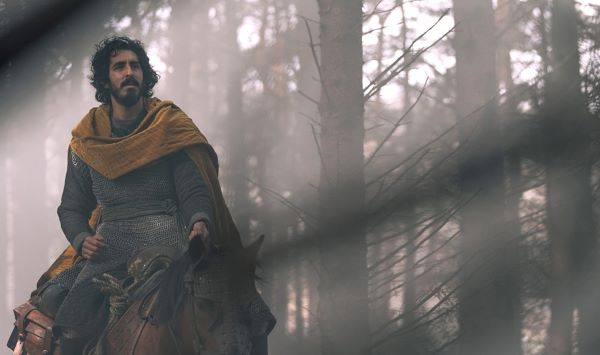
In the past decade, director David Lowery has established himself as an intriguing, uneven presence in the film world. A Ghost Story (2017), which represented the titular ghost with a sheet with black circles for eyes, contained some beautiful images and was arresting when it played with the passage of time, yet it ultimately struck me as precious and strained, grasping too hard for meaning and weight. By contrast, 2013’s Ain’t Them Bodies Saints, a movie with no novelty whatsoever in its premise and which owes an incredible debt to the masterpieces of the “outlaws in love on the run” genre (such as Badlands), was precise and moving, animated by strong imagery and beautiful performances. Most recently, The Old Man and the Gun was charming and unpretentious, featuring some beautiful work from Robert Redford and Sissy Spacek, and it did not attempt the poetic sweep of his previous work. All of this is to say, Lowery is utterly unpredictable, an impression The Green Knight confirms in spades.
Filmed in the enigmatic register of A Ghost Story and Ain’t Them Bodies Saints, his new movie takes the anonymous 14th-century poem Sir Gawain and the Green Knight, which has been translated by many renowned poets, as its basis. In this tale, the mysterious Green Knight (Ralph Ineson) interrupts King Arthur’s court and offers a wager: he challenges a brave knight to decapitate him. The Green Knight will let this happen without protest, provided that, one year hence, he be allowed to do the same to his opponent. Sir Gawain (Dev Patel) accepts the challenge and agrees to the terms and cuts off the man’s head. The Green Knight then picks his head up off the ground, confirms that he and Gawain will meet again one year hence, and gallops away. The rest of the tale involves Gawain’s attempt to meet him.
Lowery is, according to interviews, deeply engaged with this text and faithful to a degree, yet he was determined to put his own spin on it. This is not a standard Hollywood King Arthur epic but one full of cryptic symbolism and oneiric intensity. Repeatedly, a group of women, who seem like the fates, gather in a circle, though their purpose is never made clear; time and space are alarmingly flexible. At one point, Gawain descends into a spring to retrieve the “head” of a woman who appears to still have one, then the light shifts, and he enters a dreamlike state, and it is never explained how he returns to land. Audiences expecting an action movie will be in for a shock. Those unfamiliar with the legend may not realize what touches are Lowery’s, but the most important one is that Gawain is not the unwaveringly brave knight of the poem but a reluctant one ridden by fear and doubt.
There are arresting aspects to this film. Whenever Gawain’s internal struggles are allowed to come clearly into focus, as in the final scene (which I will not spoil), the movie wakes up. There are also some intriguing games with time that Lowery plays, in which we see alternate futures, according to choices Gawain does not make. It is also set in a multiethnic Medieval England, and there are some imaginative touches with the addition of a fox companion and a haunting scene of giants walking through the mountains.
As much as I admire the ambition of this film, it still goes completely off the rails. While it was clearly Lowery’s intention to make an enigmatic movie, one has the feeling that he is not in full command of his craft. There are two problems, writ large. One is that the film is so preoccupied with its attempt to be and sound significant that ultimately nothing feels meaningful at all. Too many scenes feature slow, intense, whispered dialogue, interwoven with a mysterious image or two—The Green Knight takes place on this exalted plane and nowhere else. Consequently, it lacks variety and is difficult to take seriously. It is never not mysterious.
The other, almost contradictory problem is that, in spite of its consistently ponderous tone, one also has the feeling that each scene is so jam-packed with ideas and tricks that none of its themes are allowed to come clearly into focus. Whenever we are reminded of Gawain’s struggle to come to terms with his knighthood, it is a genuine shock, since Lowery has done everything in his power to distract us from it.
So this one is, in my opinion, a mess (though I will fully concede that I might have missed something). Yet at the very least, it is a mess unlike anything else I’ve seen. The film takes one of the coziest possible narratives (the quest) and turns it into something strange and disorienting, and for that alone it is worth viewing.
One expects that Lowery will remain hard to predict. If there is a conclusion to come to about his work, it is that he is at his best when he refrains from overt grasps at profundity and focuses more on emotion and character. Ain’t Them Bodies Saints and The Old Man and the Gun, different though they are, both testify to this strength.






Leave A Comment